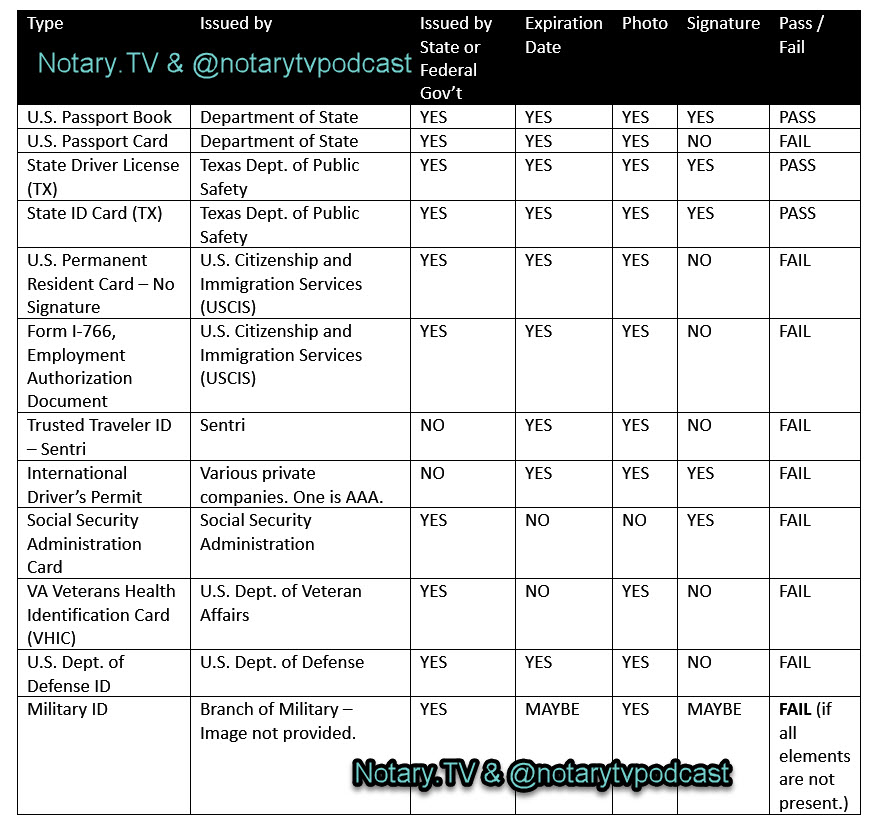Good morning from Texas and @NotaryTVPodcast!
Today, we have a few things to cover; all of the topics fall under the heading of “Methods of Identifying Signers.”
Three Legal Methods for Texas Notaries
There are three legal methods for Texas notaries to use when identifying signers. A notary must write in the record book which method was used. (See Tex. Gov’t Code 406.014(a)(5)[1]; TAC 87.40[2].)
The three methods are:
- Personal Knowledge
- Use of a Credible Witness
- Use of a Credential
Let’s go over the first two methods briefly and focus on the use of a credential. In a future episode, we will cover the first two in depth.
The reason we are presenting it in this manner and skipping a deep dive into the Personal Knowledge method and Use of a Credible Witness is because notaries have the most questions about use of a credential. Use of a credential is the most common that we use as mobile notaries and notary signing agents.
Method 1: Personal Knowledge
If the notary knows the signer well, the notary may proceed without additional identification.
Method 2: Use of a Credible Witness
There are actually two ways that the Credible Witness Method of identifying a signer may be accomplished.
ONE – The notary knows the credible witness well, and the credible witness introduces the signer to the notary.
TWO – The notary doesn’t know the credible witness personally but is allowed to identify the credible witness using an acceptable credential.
Method 3 : Use of a Credential
In this scenario, the notary accepts a proper credential in order to determine the identification of the signer. (Credentials are also known as identification cards or ID.)
Credential Requirements
There are many types of credentials that notaries are asked to accept as identification that are not authorized by law because they don’t meet the legal requirements.
These three types of credentials are the most common and most reliable. They also meet the requirements set by Texas laws.(See Tex. Gov’t Code 406.014(a)(5)[3]; TCPRC 121.005(a)(2)[4]; TAC 87.1(1)[5].)
- U.S. Passport Books (U.S. Passport Cards do not meet the law’s requirements because they do not have a signature.)
- State driver licenses
- State-issued identification card
Requirements for Credentials
- Must be issued by the federal government or a state government, as defined by Tex. Gov’t Code 311.05 which says (paraphrased):
- By definition, “federal” includes a department, bureau, or other agency of the United States of America.
- By definition, “state” includes any state, district, commonwealth, territory, and insular possession of the United States and any area subject to the legislative authority of the United States of America.
- Must have an expiration date and be current.
- Must include a signature.
- Must display a photo of the credential owner.
Samples of Acceptable and Unacceptable Credentials
Spend some time going through this list and learn to look at a credential and determine if it meets the criteria required by our Texas notary laws. In the list below, there are three forms of ID that meet the legal requirements.
Military ID Is usually a “FAIL” because all elements are seldom present. Keep in mind that it is never acceptable to copy or photograph a military ID. This is according to U.S. Code, Title 18, Part I, Chapter 33, Section 701 – Official badges, identification cards, other insignia which states they may not be copied.

[1] TGC Sec. 406.014(a)(5). NOTARY RECORDS. (a) A notary public other than a court clerk notarizing instruments for the court shall keep in a book a record of: (5) whether the signer, grantor, or maker is personally known by the notary public, was identified by an identification card issued by a governmental agency or a passport issued by the United States, or was introduced to the notary public and, if introduced, the name and mailing address of the individual introducing the signer, grantor, or maker. [NOTE: Texas Gov’t Code 406.014(a)(5) is only one item cited in a long list of notary journal requirements.]
[2] TAC §87.40. Traditional Notarization Procedures. (a) A traditional notary public shall not perform a notarization if the principal does not personally appear before the notary at the time of notarization in accordance with §87.1 of this title (relating to Definitions). (b) The methods by which a traditional notary public identifies a principal are as follows: (1) Traditional notary public personally knows the principal; or (2) Principal is introduced by oath of credible witness who personally knows the principal, and either is personally known to the traditional notary public or provides qualifying identification in accordance with paragraph (3) of this subsection; or (3) Identification by a credential. (c) For all notarial acts that require a notarial certificate, the traditional notary public shall attach a notarial certificate that names the principal, the date of the notarization, the state and county in which the notarization is performed, and language evidencing the type of notarial act performed. The notarial certificate shall be signed and include an impression of the notary’s seal. (d) The traditional notary public shall keep a record of all notarial acts in accordance with §406.014, Government Code, and this chapter. (e) This section shall apply to a traditional notary public who performs notarizations on tangible or electronic records.
[3] See footnote #1.
[4] TCPRC Sec. 121.005. PROOF OF IDENTITY OF ACKNOWLEDGING PERSON. (a) An officer may not take the acknowledgment of a written instrument unless the officer knows or has satisfactory evidence that the acknowledging person is the person who executed the instrument and is described in it. An officer may accept, as satisfactory evidence of the identity of an acknowledging person, only:
(1) the oath of a credible witness personally known to the officer;
(2) a current identification card or other document issued by the federal government or any state government that contains the photograph and signature of the acknowledging person; or
(3) with respect to a deed or other instrument relating to a residential real estate transaction, a current passport issued by a foreign country.
(b) Except in a short form certificate of acknowledgment authorized by Section 121.008, the officer must note in the certificate of acknowledgment that:
(1) he personally knows the acknowledging person; or
(2) evidence of a witness or an identification card or other document was used to identify the acknowledging person.
[5] TAC §87.1(1). Definitions. Words and terms defined in the Texas Government Code, Chapter 406, shall have the same meaning in this chapter. For the purposes of this chapter the following words and terms shall have the following meanings unless the context clearly indicates otherwise.
(1)Credential means a valid, unexpired identification card or other document issued by the federal government or any state government, as defined by §311.05 of the Government Code, that contains the photograph and signature of the principal. With respect to a deed or other instrument relating to a residential real estate transaction, credential also includes a current passport issued by a foreign country.

Leave a Reply